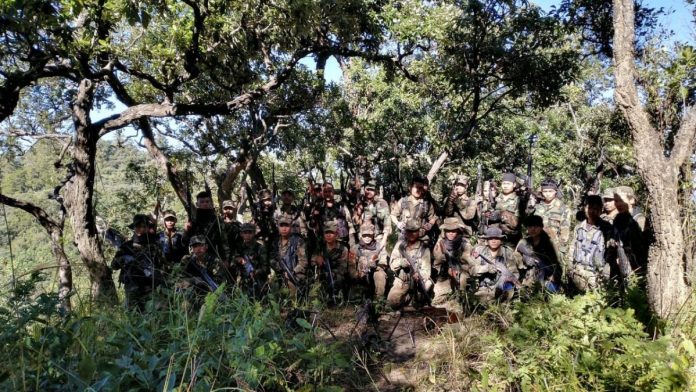
New Delhi: On Saturday, in one of the deadliest attacks in the recent past in the Northeast, the Commanding Officer of the 46 Assam Rifles, Colonel Viplap Tripathi, his wife, their eight-year-old son, and four soldiers were killed in an ambush by militants in the trouble-prone Churachandpur district of Manipur, close to the Indo-Myanmar border.
The Manipur-based militant groups, People’s Liberation Army (PLA) and the Manipur Naga People’s Front (MNPF), have claimed responsibility for the attack.
The Indian security establishment believes that both groups are being backed by the Chinese with regular supply of arms and finances.
The two organisations released a statement with a picture showing a group of about 30 cadres brandishing Kalashnikov rifles, who had carried out the attack, which sources in the defence and security establishment say was “well planned”.
Even though both the PLA and MNPF have claimed that they were not aware of the fact that the wife and child of the officer were travelling in the vehicle, sources said this is not possible since a convoy is closely monitored for an ambush.
“They knew that the officer’s wife and child were in the vehicle and still went ahead with the ambush,” a source said, adding that they knew when the convoy left for the headquarters from the company base.
This means that someone was monitoring the convoy, the source said, adding that the militant groups knew who all were in the convoy.
ThePrint had reported that the ambush began with an IED blast directed at the vehicle of the commanding officer, which was followed by a heavy burst of fire from automatic weapons.
Pictures of the bullet-ridden vehicle shows that the firing came from multiple sides.
ThePrint takes a look at the two organisations that have claimed responsibility for the attack.
The People’s Liberation Army
The PLA was founded on 25 September 1978, under the leadership of N.. Bisheshwar. On 25 February 1979, its political wing, the Revolutionary People’s Front (RPF), was set up.
The birth of the PLA led to a high intensity insurgency, which led to the Manipur government declaring the entire Valley as a disturbed area. The Armed Forces (Special Powers) Act, 1958, was imposed in the Valley in September 1980.
According to the Army, the RPF suffered a major setback soon after its formation when its chief Bisheshwar was captured and seven other leaders were killed by the Indian Army in an operation in Tekcham, Thoubal district, on 6 July, 1981.
In October the same year, the RPF, along with the People’s Revolutionary Party of Kangleipak (PREPAK) and Kangleipak Communist Party (KCP), were declared unlawful organisations.
Security forces continued their operations against the groups and on 13 April, 1982, the RPF’s then leader, Thoudam Kunjabehari, and eight other militants of the outfit were killed in an encounter at Kadampokpi area, near Imphal.
This led to a slowdown in the activities of the PLA and the RPF but by the late 1980s, it was back in action in a big way.
PLA militants carried out an ambush near Imphal on 8 April, 1989, killing Vandana Mallick, an Indian Police Service (IPS) officer.
In 1990, RPF imposed a ban on the sale of liquor in Manipur and its cadres took up a fight against drug peddlers and also gunned down rapists.
The Army says that PLA forced corrupt officials and contractors to confess their guilt through local newspapers.
In August 1995, the group’s founder Bisheshwar was gunned down by the PLA for contesting in the state assembly elections and accepting the Indian Constitution.
From 1991, the RPF began observing 15 October (the day Manipur merged with the Union of India) as a Black Day and since 1995, has been observing 25 February as its Independence Demand Day.
Subsequently the PLA was reorganised on the lines of a regular army into three bureaus – Central, Western and Eastern.
The Indian Army says that all the decisions of the party are taken by the Central bureau and the RPF has divided Manipur for administrative purposes into six divisions, each led by a commander.
Manipur Naga People’s Front (MNPF)
In 2013, two Naga underground outfits in Manipur — the Manipur Naga Revolutionary Front (MNRF) and the United Naga People’s Council (UNPC) — merged and formed the Manipur Naga People’s Front (MNPF). Its armed wing was called the Manipur Naga People’s Army.
According to a statement then issued by MNPF deputy publicity secretary Thomas Numai, with the formation of MNPF, the MNRF and UNPC had been dissolved.
The statement said that a decision to dissolve the two outfits and work together under one banner was adopted at a joint meeting of the two parties.
“Time has come for us to struggle together to achieve our common goal by surrendering one’s own interest and giving room to accommodate other parallel bodies,” the statement said. “We encompass all parties for a united struggle which is our loud and clear message. We shall not demoralise our political vision by remaining aloof like the organisations under cease-fire pacts whose interest is either higher autonomy or economic package”.
It said that the principal objective of the MNPF was restoration of sovereignty and right to self-determination.
Another objective was bridging the gap of all revolutionary groups of the region — Assam, Arunachal Pradesh, Meghalaya, Mizoram, Manipur, Nagaland and Tripura.
(Edited by Arun Prashanth)
Subscribe to our channels on YouTube & Telegram
Why news media is in crisis & How you can fix it
India needs free, fair, non-hyphenated and questioning journalism even more as it faces multiple crises.
But the news media is in a crisis of its own. There have been brutal layoffs and pay-cuts. The best of journalism is shrinking, yielding to crude prime-time spectacle.
ThePrint has the finest young reporters, columnists and editors working for it. Sustaining journalism of this quality needs smart and thinking people like you to pay for it. Whether you live in India or overseas, you can do it here.